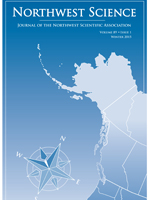Biotic and abiotic factors influence fish populations and distributions. Concerns have been raised about the influence of hatchery fish on wild populations. Carson National Fish Hatchery produces spring Chinook salmon Oncorhynchus tshawytscha in the Wind River, Washington, and some spawn in the river. Managers were concerned that Chinook salmon could negatively affect wild steelhead O. mykiss and that a self-sustaining population of Chinook salmon may develop. Our objectives were to assess: 1) the distribution and populations of juvenile spring Chinook salmon and juvenile steelhead in the upper Wind River; 2) the influence of stream flow and of each population on the other; and 3) if Chinook salmon populations were self-sustaining. We snorkeled to determine distribution and abundance. Flow in the fall influenced upstream distribution and abundance of juvenile Chinook salmon. Juvenile Chinook salmon densities were consistently low (range 0.0 to 5.7 fish 100 m-2) and not influenced by number of spawners, winter flow magnitude, or steelhead abundance. Juvenile steelhead were distributed through the study section each year. Age-0 and age-1 steelhead densities (age-0 range: 0.04 to 37.0 fish 100 m-2; age-1 range: 0.02 to 6.21 fish 100 m-2) were consistently higher than for juvenile Chinook salmon. Steelhead spawner abundance positively influenced juvenile steelhead abundance. During this study, Chinook salmon in the Wind River appear to have had little effect on steelhead. Low juvenile Chinook salmon abundance and a lack of a spawner-to-juvenile relationship suggest Chinook salmon are not self-sustaining and potential for such a population is low under current conditions.
How to translate text using browser tools
1 January 2015
Biotic and Abiotic Influences on Abundance and Distribution of Nonnative Chinook Salmon and Native ESA-Listed Steelhead in the Wind River, Washington
Ian G. Jezorek,
Patrick J. Connolly
ACCESS THE FULL ARTICLE

Northwest Science
Vol. 89 • No. 1
January 2015
Vol. 89 • No. 1
January 2015
Chinook salmon
juvenile salmonid density
non-native species
steelhead




